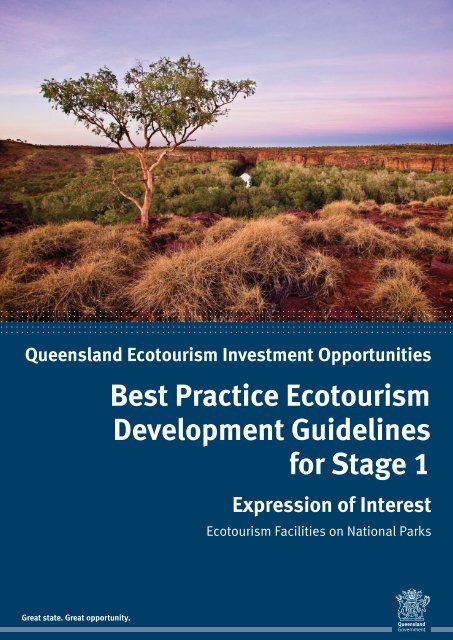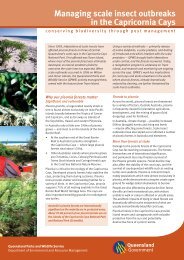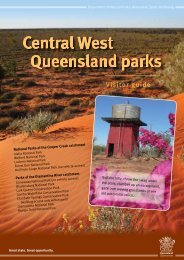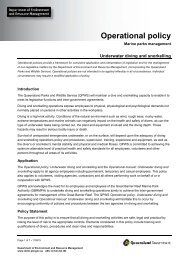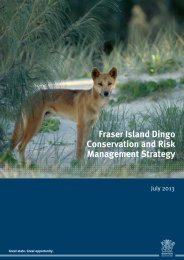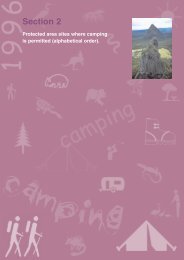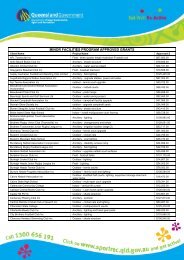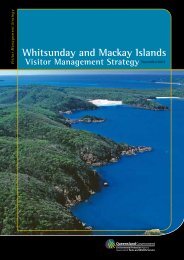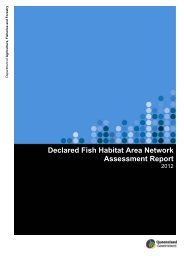Best Practice Ecotourism Development Guidelines for Stage 1
Best Practice Ecotourism Development Guidelines for Stage 1
Best Practice Ecotourism Development Guidelines for Stage 1
Create successful ePaper yourself
Turn your PDF publications into a flip-book with our unique Google optimized e-Paper software.
Queensland <strong>Ecotourism</strong> Investment Opportunities<br />
<strong>Best</strong> <strong>Practice</strong> <strong>Ecotourism</strong><br />
<strong>Development</strong> <strong>Guidelines</strong><br />
<strong>for</strong> <strong>Stage</strong> 1<br />
Expression of Interest<br />
<strong>Ecotourism</strong> Facilities on National Parks<br />
Great state. Great opportunity.
1. Introduction<br />
The DestinationQ Partnership Agreement established between the Queensland Government and<br />
the Queensland Tourism Industry Council on 26 June 2012 identified the demand <strong>for</strong> new, unique<br />
and low impact ecotourism facilities on national parks to attract domestic and international visitors<br />
to Queensland.<br />
The <strong>Best</strong> <strong>Practice</strong> <strong>Ecotourism</strong> <strong>Development</strong> <strong>Guidelines</strong> <strong>for</strong> <strong>Stage</strong> 1 – Expression of Interest (<strong>Stage</strong> 1<br />
<strong>Best</strong> <strong>Practice</strong> <strong>Guidelines</strong>) have been developed to ensure that new and expanded ecotourism<br />
opportunities on Queensland national parks achieve industry best practice. The <strong>Stage</strong> 1 <strong>Best</strong><br />
<strong>Practice</strong> <strong>Guidelines</strong> provide proponents with a guide on how ecotourism facilities can be effectively<br />
integrated into national parks through awareness of:<br />
• site values and constraints, appropriate site layout, design and construction<br />
• low energy footprint, water and waste systems<br />
• appropriate visitor interpretation and activities; and<br />
• community partnerships.<br />
The Queensland Government will use these guidelines during the expression of interest –<br />
preliminary concept assessment stage to assist in determining whether the proposed ecotourism<br />
use of a national park aligns with national park values and can be undertaken in an ecologically<br />
sustainably manner.<br />
Proponents should refer to the best practice ecotourism development criteria and sample prompt<br />
questions outlined in these guidelines when preparing their response to expressions of interest<br />
(EOI) <strong>for</strong> Queensland ecotourism investment opportunities. Sustainability related questions<br />
are presented in EOI tender guidelines and an application <strong>for</strong>m which are linked to the best<br />
practice ecotourism development criteria. It is government’s expectation that proponents will<br />
have considered these social, economic and environmental criteria in preparing and submitting<br />
an application.<br />
The <strong>Stage</strong> 1 <strong>Best</strong> <strong>Practice</strong> <strong>Guidelines</strong> have been in<strong>for</strong>med by a review of equivalent guidelines<br />
used by other state governments and, in particular, the Sustainability <strong>Guidelines</strong> <strong>for</strong> Visitor Use<br />
and Tourism in NSW National Parks. The <strong>Stage</strong> 1 <strong>Best</strong> <strong>Practice</strong> <strong>Guidelines</strong> are aligned with the<br />
Queensland <strong>Ecotourism</strong> Plan 2013–2020 and should be read in conjunction with the <strong>Ecotourism</strong><br />
Facilities on National Parks Implementation Framework.<br />
Hinchinbrook Island National Park, Photo courtesy of Tourism and Events Queensland<br />
Front cover: Boodjamulla (Lawn Hill) National Park , Mark Nemet, Queensland Government<br />
1
2. Legislative and policy context<br />
National parks are exceptional places declared under the Nature<br />
Conservation Act 1992 (the NC Act) as representing Queensland’s<br />
biological diversity and outstanding natural and cultural<br />
features and wilderness. The Department of National Parks,<br />
Recreation, Sport and Racing (NPRSR) has responsibility <strong>for</strong> over<br />
320 national parks, including five World Heritage Areas. National<br />
park values include provision of life supporting ecosystem<br />
services, protection of biodiversity, environmental education,<br />
conserving wildlife, recreation and tourism, protection of cultural<br />
heritage and providing landscape amenity.<br />
NPRSR is developing a range of policy and legislative measures<br />
to improve opportunities <strong>for</strong> ecotourism and visitor use on<br />
national parks. A key initiative of the Queensland Government<br />
is the amendment of the NC Act to allow <strong>for</strong> privately<br />
funded and operated ecotourism infrastructure on national<br />
park. The amended Section 35 of the NC Act allows <strong>for</strong> the<br />
authorisation of ecotourism facilities on national parks where<br />
use of the land <strong>for</strong> this purpose is:<br />
• in the public interest<br />
• ecologically sustainable; and<br />
• provides to the greatest possible extent the preservation of<br />
the land’s natural condition and protection of cultural values<br />
and resources.<br />
The Queensland <strong>Ecotourism</strong> Plan 2013–2020 seeks to position<br />
Queensland as the number one ecotourism destination in<br />
Australia and as a world leader in ecotourism. This vision will be<br />
achieved through a number of strategic actions that facilitate the<br />
development of high quality ecotourism experiences, build the<br />
profile of the industry and increase visitation. The <strong>Best</strong> <strong>Practice</strong><br />
<strong>Ecotourism</strong> <strong>Development</strong> <strong>Guidelines</strong> contributes to the improved<br />
planning and delivery of world leading ecotourism opportunities<br />
on national parks.<br />
The <strong>Ecotourism</strong> Facilities on National Parks Implementation<br />
Framework provides the model <strong>for</strong> assessment and approval<br />
of proposals <strong>for</strong> ecotourism facilities on national parks. The<br />
framework in<strong>for</strong>ms proponents and the broader community<br />
of how NPRSR will assess ecotourism facility proposals, the<br />
matters that will be considered and the approval and leasing<br />
arrangements <strong>for</strong> successful proposals. The implementation<br />
framework also outlines guiding principles <strong>for</strong> establishing<br />
ecotourism facilities on national parks.<br />
The <strong>Best</strong> <strong>Practice</strong> <strong>Ecotourism</strong> <strong>Development</strong> <strong>Guidelines</strong> <strong>for</strong> <strong>Stage</strong> 1<br />
describe the key considerations <strong>for</strong> achieving environmental,<br />
economic and social sustainability outcomes and can be applied<br />
by proponents in a manner that is appropriate to the nature,<br />
scale and location of their proposal.<br />
Proponents are encouraged to be familiar with both the policy<br />
context and the legislative requirements <strong>for</strong> ecotourism facilities<br />
on national park.<br />
Bunya Mountains National Park<br />
Photo courtesy of Tourism and Events Queensland<br />
2
3. <strong>Best</strong> practice ecotourism<br />
development<br />
The <strong>Best</strong> <strong>Practice</strong> <strong>Ecotourism</strong> <strong>Development</strong> <strong>Guidelines</strong> <strong>for</strong> <strong>Stage</strong><br />
1 provide six best practice criteria <strong>for</strong> proponents to incorporate<br />
into the development and planning of their ecotourism concept.<br />
These guidelines will help ensure that ecotourism facilities<br />
and associated activities are ecologically sustainable, seek to<br />
preserve the land’s natural condition and cultural values, are in<br />
the public interest and are designed and managed to facilitate<br />
the presentation and appreciation of conservation values.<br />
The definition of ‘ecological sustainability’ provided in the<br />
NC Act is:<br />
“within the capacity of the land to sustain natural processes<br />
while (a) maintaining the life support systems of nature; and<br />
(b) ensuring the benefit of the use to present generations does<br />
not diminish the potential to meet the needs and aspirations of<br />
future generations.”<br />
In the context of ecotourism facilities, ecologically sustainable<br />
use of national parks means:<br />
• the facility and associated activities are integrated within the<br />
constraints or capacity of the national park<br />
• the facility and associated activities are based on an<br />
understanding of how the national park functions as an<br />
ecosystem, and their cultural resource<br />
• The facility and associated activities enhance the<br />
parks presentation<br />
• facilities and activities are designed and operated in a manner<br />
that does not impose any additional stress or constraint on<br />
the national park; and<br />
• operators pursue initiatives that support the national park’s<br />
long-term viability.<br />
<strong>Best</strong> practice ecotourism developments require considerations<br />
broader than just the ecological. <strong>Ecotourism</strong> facilities on national<br />
parks have the potential to influence the landscape, ecosystems,<br />
local communities, interest groups and park management,<br />
which all interact in a complex and integrated system. Increased<br />
visitation to national parks can assist in raising public awareness<br />
of their critical importance, especially when the experiences are<br />
interpreted or facilitated by a well-in<strong>for</strong>med ecotourism operator.<br />
By imparting in<strong>for</strong>mation to visitors, and combining naturebased<br />
experiences, the role national parks play in protecting and<br />
conserving biodiversity and cultural heritage can be rein<strong>for</strong>ced.<br />
Similarly the involvement of Traditional Owners and local<br />
communities in ecotourism can build the cultural resources of<br />
the national park and support regional economic development.<br />
<strong>Best</strong> practice ecotourism facilities are in the public interest and<br />
can contribute the resources necessary to protect and conserve<br />
national parks <strong>for</strong> future generations. These operations build<br />
partnerships and contribute to park management in a way that<br />
maintains or enhances the national park’s cultural and ecological<br />
integrity.<br />
The best practice ecotourism development criteria outlined<br />
in these guidelines will help ensure the ecotourism facilities<br />
on Queensland national parks are ecologically sustainable,<br />
demonstrate a high level of sensitivity and harmony with the<br />
natural and cultural values of the site, and rein<strong>for</strong>ce and support<br />
conservation and community values.<br />
Glass House Mountains National Park<br />
Photo courtesy of Tourism and Events Queensland<br />
3
4. Application<br />
The Queensland Government has developed a two stage process<br />
<strong>for</strong> assessing ecotourism opportunities. Figure 1 provides an<br />
overview of the steps involved in two-staged process:<br />
• <strong>Stage</strong> 1 – Preliminary Concept Assessment requires the<br />
proponent to develop a concept proposal and present the<br />
in<strong>for</strong>mation in a standard response <strong>for</strong>m provided in the<br />
expression of interest (EOI) tender documentation.<br />
• <strong>Stage</strong> 2 – Full Proposal Assessment requires the proponent<br />
to develop a detailed proposal in response to a full terms of<br />
reference that will be determined on a case-by-case basis.<br />
The <strong>Best</strong> <strong>Practice</strong> <strong>Ecotourism</strong> <strong>Development</strong> <strong>Guidelines</strong> <strong>for</strong><br />
<strong>Stage</strong> 1 and <strong>Stage</strong> 2 have been developed to assist proponents<br />
incorporate sustainability considerations into the planning<br />
and development of their proposals and should in<strong>for</strong>m the<br />
proponents application. The <strong>Stage</strong> 1 best practice ecotourism<br />
development criteria highlight considerations relevant to the<br />
concept or early planning phase. The government evaluation<br />
panel will use the guidelines as one of the tools <strong>for</strong> assessing<br />
and short listing successful proponents.<br />
The <strong>Best</strong> <strong>Practice</strong> <strong>Ecotourism</strong> <strong>Development</strong> <strong>Guidelines</strong> <strong>for</strong> <strong>Stage</strong> 2<br />
(<strong>Stage</strong> 2 <strong>Best</strong> <strong>Practice</strong> <strong>Guidelines</strong>) will provide more detailed<br />
guidance on the best practice design, construction and operation<br />
of ecotourism facilities on national parks, supported by industry<br />
standards and case studies. Application of the <strong>Stage</strong> 2 <strong>Best</strong><br />
<strong>Practice</strong> <strong>Guidelines</strong> will be determined according to the nature,<br />
scale and location of the proposal.<br />
Figure 1: Assessment process <strong>for</strong> Queensland ecotourism<br />
investment opportunities<br />
<strong>Stage</strong> 1 <strong>Stage</strong> 2<br />
Step 1:<br />
Step 2:<br />
Step 3:<br />
Step 4:<br />
Step 5:<br />
Step 6:<br />
Government<br />
releases general<br />
EOI to industry<br />
EOI evaluation<br />
panel shortlists<br />
proposals<br />
and makes a<br />
recommendation<br />
to the Director-<br />
General NPRSR<br />
to approve<br />
NPRSR prepares<br />
terms of reference<br />
<strong>for</strong> full proposal<br />
assessment,<br />
streamlining<br />
local/state/<br />
federal approval<br />
processes where<br />
possible<br />
Proponent<br />
undertakes<br />
assessment as<br />
appropriate to<br />
scale and impact<br />
of the project<br />
‘In principle<br />
approval’ provided<br />
by Director-General<br />
NPRSR, subject<br />
to outstanding<br />
approvals/<br />
conditions<br />
Lease/authority<br />
granted by Director<br />
-General NPRSR to<br />
proponent<br />
4
5. <strong>Best</strong> practice ecotourism<br />
development criteria<br />
The best practice criteria outlined in Table 1 represent the key<br />
factors that proposals <strong>for</strong> ecotourism facilities need to address<br />
in <strong>Stage</strong> 1 to be considered an appropriate use under the NC<br />
Act. The criteria are relevant to the concept planning stage of<br />
a proposal and are intended to set best practice standards<br />
<strong>for</strong> permanent infrastructure and associated visitor activity on<br />
national parks.<br />
Proponents are encouraged to address the best practice criteria<br />
to the extent that is relevant to the proposed site location and<br />
the size and scale of the proposed facility. Table 2 provides<br />
additional guidance including sample questions that may assist<br />
proponents in refining and developing their ecotourism concept.<br />
The sample questions are not intended to be an exhaustive list<br />
of examples and proponents are encouraged to be innovative in<br />
their response to the criteria.<br />
Table 1: <strong>Best</strong> practice ecotourism development criteria<br />
Wilson Island, Capricornia Cays National Park<br />
Photo courtesy of Tourism and Events Queensland<br />
No. Criteria Values<br />
1 The facility is compatible with the natural and cultural values of the national park.<br />
Environmental<br />
The natural and cultural values of the site are known. Any constraints or stressors on the<br />
system are identified and development on sensitive and vulnerable areas is avoided.<br />
2 The facility is designed to fit within the character of the national park.<br />
The design and layout of the facility is in harmony with the landscape and natural<br />
features. Climate sensitive design features capture the benefit of sun, rain and<br />
shade. Construction materials are local or renewable and the site is landscaped with<br />
native species.<br />
3 The facility minimises its footprint on the site.<br />
Impacts on the site are minimised through the construction and operation of the facility.<br />
The facility promotes water and energy conservation and a ‘leave no trace’ philosophy is<br />
applied in relation to visitor activity on site. Waste and pollution is minimised.<br />
4 The facility contributes to protecting and positively enhancing the national park.<br />
The long-term viability of the national park is supported by working with park<br />
management and local groups to, <strong>for</strong> example, reduce environmental stressors on the<br />
park system, rehabilitate disturbed areas of the park, and educate staff and visitors<br />
regarding intrinsic park values.<br />
5 The facility engages, involves and benefits Traditional Owners and local communities.<br />
The importance of the national park to the cultural and economic priorities of local<br />
communities is identified and long-term partnerships pursued. Traditional Owners are<br />
involved in the interpretation and experience of Indigenous cultural resources.<br />
6 The facility encourages visitors to appreciate and want to protect and conserve the<br />
national park.<br />
The natural and cultural values of the site are appropriately interpreted, and visitor<br />
activities and experiences support the protection and conservation of these values.<br />
The facility is developed to achieve third-party certification <strong>for</strong> sustainable building<br />
design and/or ecotourism.<br />
Environmental<br />
Environmental<br />
Environmental<br />
Social<br />
Social<br />
Economic<br />
Social<br />
Environmental<br />
Economic<br />
5
Table 2: <strong>Best</strong> practice ecotourism development sub-criteria and sample questions<br />
Note: The sample questions outlined in this table are intended to assist proponents in responding to the best practice ecotourism development criteria. Commensurate with the nature, scale and<br />
location of development only certain criteria and questions apply. Proponents are not required to respond to each of these sample questions, but are encouraged to consider them as guides <strong>for</strong><br />
practical application of the criteria. Some questions may require more detailed understanding of the site and ecotourism concept than proponents may have available at this stage. These questions<br />
have been included to encourage whole of project planning at the preliminary concept stage.<br />
Criteria Sub-criteria Sample questions<br />
1. The facility is<br />
compatible with<br />
the natural and<br />
cultural values of the<br />
national park.<br />
1.1 Protecting and<br />
conserving natural<br />
and cultural values<br />
1.2 Site access and<br />
suitability<br />
• What are the natural values of the national park taking into consideration known listed and protected species and habitat?<br />
• What are the cultural values of the national park taking in to consideration known cultural heritage, artefacts and non-physical values?<br />
• What is the capacity of natural and cultural values to sustain the facility development impacts and visitor activity over time? Are there any specific<br />
constraints or vulnerabilities? (e.g. park management plans may provide guidance)<br />
• Is construction and operation of the facility expected to impact the national park’s natural values? How can impacts be adequately mitigated?<br />
Would it be possible to achieve no net impact or possible enhancements to natural and cultural values of the site?<br />
• Are strategies required to protect sensitive habitat areas and/or avoiding activity in vulnerable or highly valued areas?<br />
• In selecting the site have previously disturbed sites been utilised where possible?<br />
• In providing access to the site have existing roads, tracks and utility corridors been utilised where possible?<br />
• Has consideration been given to locate the development and activity on lower value habitat as opposed to high conservation areas?<br />
• Does the facility and associated activity avoided high conservation areas, riparian zones and narrow and steep slopes, etc?<br />
• Has there been a clear demarcation of the long term development footprint, including appropriate barriers to limit activity to stabilised or<br />
designated areas?<br />
6
Criteria Sub-criteria Sample questions<br />
2. The facility is<br />
designed to fit within<br />
the character of the<br />
national park.<br />
2.1 Site layout is<br />
compatible with the<br />
landscape<br />
2.2 Facility design<br />
and appearance is<br />
compatible with the<br />
landscape<br />
• In planning the site layout will landscape features predominate and/or will the facility blend into the surrounding environment?<br />
• Will the facility design and layout maximise use of landscape features and natural geological <strong>for</strong>mations of the site?<br />
• Will the design allow natural sights, sounds and scents to prevail throughout the facility?<br />
• Has consideration been given to either dispersing or concentrating the facility infrastructure to achieve minimal environmental impact?<br />
• Has consideration been given to the microclimate of the site and how factors such as aspect, exposure, elevation and wind can be utilised to<br />
maximise visitor com<strong>for</strong>t without depending on mechanical systems?<br />
• Is the overarching design philosophy of the facility based on climate sensitive design and a strong ‘sense of place’?<br />
• Does the facility use aspect and orientation to provide insulation, ventilation, passive heating and cooling?<br />
• Are landscape features reflected in design through scale, <strong>for</strong>m, colour and texture of the facility?<br />
• Is the architectural style and materials of the facility reflective of aspects of local indigenous culture (if appropriate)?<br />
• How is the facility designed so that it does not dominate landscape features? Have ‘biomimicry’ concepts been utilised such as tree-house style<br />
accommodation or cabins the colour and shape of surrounding boulders?<br />
• Will future landscaping use local species which require minimal maintenance and are essentially self-sustaining?<br />
• Does the facility aim <strong>for</strong> smaller is better, optimising use and flexibility of spaces so building size and associated resources required <strong>for</strong><br />
construction are minimised?<br />
• Will sustainability features such as recycled materials, efficient water and energy systems and waste minimisation practices be visible throughout<br />
the site?<br />
• Has adaptive re-use of existing structures been considered to reflect part of the story of the site?<br />
• Is there an intention to obtain third-party sustainable building certification or accreditation <strong>for</strong> the facility?<br />
7
Criteria Sub-criteria Sample questions<br />
3. The facility<br />
minimises its<br />
footprint on the site.<br />
3.1 Facility<br />
construction<br />
methods are<br />
low impact<br />
3.2 Energy<br />
conservation<br />
practices<br />
are employed<br />
3.3 Water<br />
conservation<br />
practices<br />
are employed<br />
• Will disturbance and clearing of habitat during construction be minimised through best practice technologies <strong>for</strong> environmentally and culturally<br />
sensitive areas?<br />
• Will the development footprint be contained during construction with impacts on surrounding areas and habitat avoided?<br />
• Has consideration been given to modular, pre-fabricated and easy to assemble construction technologies to reduce construction related impacts?<br />
• Have locally sourced and lightweight yet durable materials and construction practices been considered?<br />
• Is there an intention to use renewable, durable, non-toxic and environmentally sustainable materials throughout the facility?<br />
• Will strategies be developed to limit pollutants and toxins brought on site during construction?<br />
• Will waste streams be managed during construction through re-use of on-site materials that are within the development zone (e.g. soils,<br />
vegetation, fabricated materials)?<br />
• Will energy required by the site be minimised <strong>for</strong> the needs of visitors and facility operation?<br />
• Will an energy efficiency strategy be developed <strong>for</strong> the construction and operation of the facility—minimising energy requirements, using energy<br />
efficient appliances and generating on-site renewable energy?<br />
• Has consideration been given to use of passive energy technologies <strong>for</strong> natural heating and cooling through the design of the facility, e.g. natural<br />
ventilation, shading and solar heating?<br />
• Has integration of energy awareness, conservation and efficiency practices into the operation of the facility and visitor experience<br />
been considered?<br />
• Has the use of renewable energy technologies that are best suited to the site and have whole of lifecycle benefits been considered, e.g. no major<br />
adverse impacts from installation or high maintenance costs?<br />
• Will water required by the site be minimised <strong>for</strong> the needs of visitors and facility operation?<br />
• Have water sensitive urban design practices, such as rainwater tanks, on-site recycling of water and/or wastewater, swales and bio-retention<br />
basins <strong>for</strong> water treatment and water efficient appliances been considered?<br />
• Have strategies to protect surface and groundwater through best practice approaches to managing pollutants and debris in stormwater run-off and<br />
sediment transport, e.g. bio-filtration technologies and sediment traps been considered?<br />
• Has the integration of water awareness, conservation and efficiency practices into the operation of the facility and visitor experience<br />
been considered?<br />
8
Criteria Sub-criteria Sample questions<br />
4. The facility<br />
contributes to<br />
protecting and<br />
positively enhancing<br />
the national park.<br />
5. The facility<br />
engages, involves<br />
and benefits<br />
Traditional<br />
Owners and<br />
local communities.<br />
4.1 Contributions to<br />
on-site rehabilitation<br />
and restoration<br />
4.2 Contributions to<br />
park management<br />
5.1 Sharing<br />
ecotourism<br />
benefits with<br />
Traditional Owners<br />
5.2 Sharing<br />
ecotourism benefits<br />
with neighbouring<br />
communities<br />
5.3 Local and<br />
regional economic<br />
development<br />
• Will strategies be developed to rehabilitate previously impacted and degraded areas, and areas currently landscaped with exotic species<br />
where appropriate?<br />
• Will strategies be developed to progressively rehabilitate areas impacted by the construction and operation of the facility?<br />
• Is there land available <strong>for</strong> resting and rehabilitating heavy use or impacted areas over time?<br />
• Will there be a commitment to partnering with park management and Traditional Owners to deliver shared park outcomes, e.g. assistance with<br />
preserving and restoring impacted areas of the natural or protected area, research and monitoring, attracting specialist studies, working with<br />
volunteers and providing funding?<br />
• Will there be a commitment to undertaking or contributing to research and/or monitoring of ‘acceptable limits of change’ <strong>for</strong> rare, vulnerable and<br />
endangered species impacted by visitation and the facility operations?<br />
• Will facility management undertake self-monitoring <strong>for</strong> continuous improvement in minimising impact of operations using environmental<br />
management systems that comply with ISO14001?<br />
• Is there an intention to seek Traditional Owner endorsement and participation in the facility including guidance and involvement in visitor<br />
interpretation and experiences?<br />
• Will the indigenous cultural heritage and cultural values of the site be respected through sensitive visitor interpretative experiences and<br />
partnerships to contribute to the long-term preservation and protection measures of these values?<br />
• Are the proposed ecotourism opportunity compatible with cultural uses of the site?<br />
• Is there an intention to engage in an ongoing dialogue with neighbouring residents and community organisations to understand their attitudes to<br />
the site and impacts (positive and negative) and continual improvement?<br />
• Has consideration been given to how the proposed ecotourism opportunity fits with existing uses of the area such as independent and commercial<br />
visitors, recreation, water production, landscape amenity, grazing and residential?<br />
• Has consideration been given to whether the ecotourism opportunity is compatible with existing tourism activities in the national park and<br />
community use of the site?<br />
• Will the ecotourism facility provide <strong>for</strong> improved community access and enjoyment of national park?<br />
• Have any economic benefits <strong>for</strong> surrounding communities been identified, e.g. local procurement of food and materials, construction, repairs and<br />
maintenance, local Indigenous arts and craft <strong>for</strong> purchase by visitors (if appropriate)?<br />
• Is there a commitment to providing employment and training opportunities <strong>for</strong> the local community?<br />
• Is there a commitment to partnering with the community to maximise the benefit from tourism including shared activities around festivals and<br />
events, hosting activities with neighbouring communities, tours of local business and/or industry?<br />
9
Criteria Sub-criteria Sample questions<br />
6. The facility<br />
encourages visitors<br />
to appreciate and<br />
want to protect<br />
and conserve the<br />
national park.<br />
6.1 Appropriate<br />
interpretation<br />
of natural and<br />
cultural values<br />
6.2 Sensitive<br />
and responsible<br />
visitor experiences<br />
and activities<br />
• Is there an intention to provide well researched in<strong>for</strong>mation on the site to visitors with appropriate qualified guides?<br />
• Have the special or unique environmental and cultural features of the site been identified, and is there an intention to build understanding into<br />
the visitor experience through responsible tourism practices, e.g. wildlife viewing doesn’t interfere with <strong>for</strong>aging, territorial or breeding patterns?<br />
• Will there be any development of educational opportunities and programs relating to aesthetic, scientific and cultural values of the site using<br />
interpretative techniques such as face-to-face Indigenous cultural education or active visitor involvement in site restoration?<br />
• What strategies will be employed to in<strong>for</strong>m visitors of local Indigenous and non-Indigenous customs and expectations regarding use of the site<br />
particularly in relation to cultural resources?<br />
• Has consideration been given to activity zones and buffers to protect sensitive habitat areas and manage visitor use and overcrowding of sites?<br />
• Is there a commitment to providing staff awareness and education on the natural and cultural values of the site and appropriate visitor activity to<br />
support conservation outcomes?<br />
• What are the strategies to prevent deliberate and regular intrusion of sensitive wildlife habitat?<br />
• Is there the intention to obtain third party ecotourism certification or accreditation?<br />
10


